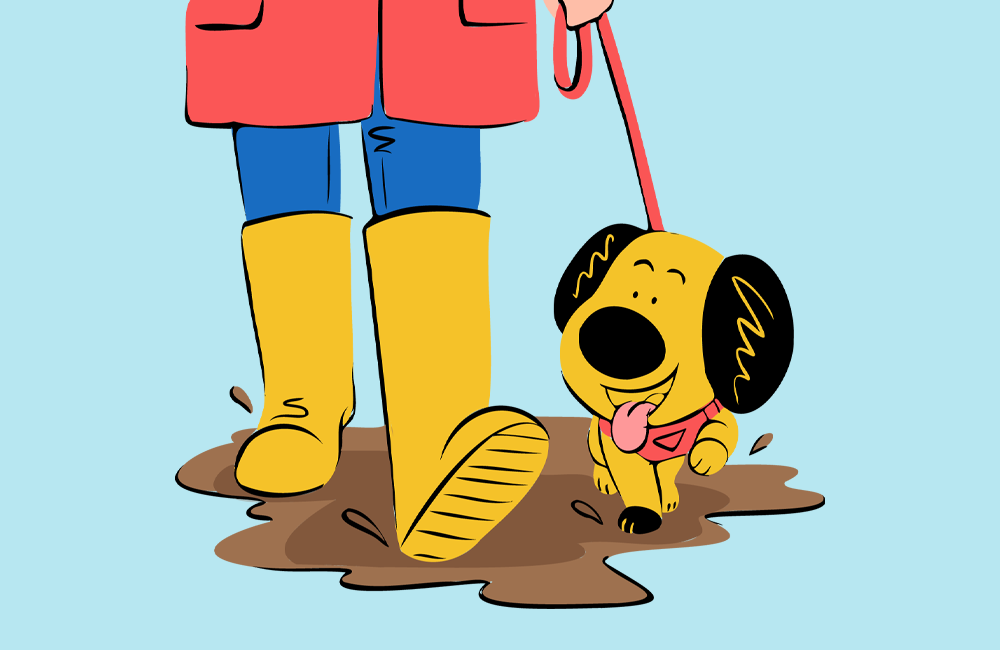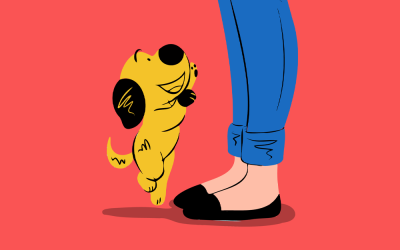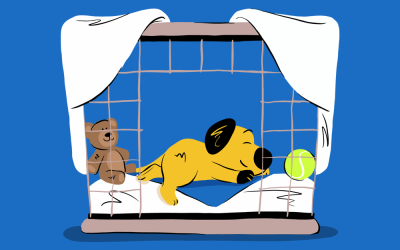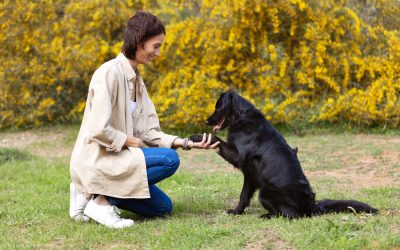How To Teach A Puppy To Walk on a Leash

Written by Petrina Firth, Zigzag Training Coach, Dog Trainer and Behaviorist for Odie Pet Insurance
Teaching a puppy to walk on leash is an important life skill, but it can either turn into a trip hazard comedy skit filled with hilarity or incredibly frustrating! And then there are those puppies who just sit down and won’t walk at all!
Whether your pup is sitting down and just won’t budge or charging ahead, there are simple training techniques you can utilize to teach your puppy to walk on leash.
Should I Use a Collar or a Harness To Walk My Puppy?
Harness for walking and a collar for ID tags is what we like to use and generally recommend here at Zigzag. Harnesses are much kinder while you’re training that over exuberant pup, whereas collars can hurt, and cause choking if your puppy suddenly lunges at a leaf or for a sniff. Once your puppy walks nicely on a harness and leash, by all means switch to a collar if you prefer it.
What Do I Need To Teach My Puppy To Walk On a Leash?
- A comfortable harness for your puppy
- A good length leash – around 6-10 feet, training leashes are good as you can adjust the length
- Treats your puppy really likes – low salt deli meat, tiny pieces of chicken, some wet dog food in a feeding tube, or grated cheese all go down well!
How to Start Puppy Leash Training
Begin at the beginning, indoors and without equipment! Follow these 5 steps to puppy leash training
1. Getting Started With Leash Training Indoors
Train indoors first — free of distractions and no need for walking equipment.
- Put some treats in your left hand and get your puppy to stand on your left side. Let them sniff the treats in your hand.
- Take a few steps forward, keeping the treats right by your puppy’s nose. Pretty cool how they follow along, right? Give them lots of praise!
- Do this a few more times, so your puppy gets used to walking next to you while following the treats.
- Once they’ve got the hang of it, keep walking, but slowly move your hand up to your hip level. If your pup walks with you, say “good!” and give them a treat.
Tip: Small, soft treats work best since your puppy can eat them quickly and get right back to walking with you.
2. Add in the harness and leash
Next, let’s get your puppy used to their gear.
- Put treats in your hand while you put on their harness and leash, and feed them as you’re doing it.
- This helps them learn that wearing these things is fun, not scary.
- If your puppy seems nervous about the harness or leash, go slow and keep giving treats. Soon they’ll think it’s no big deal.
- Once everything’s on, practice walking around your house just like before. Keep rewarding your puppy with treats when they walk next to you.
Tip: Take it slow and make it fun! Don’t rush outside yet! Start in your house where it’s quiet, and your pup can focus, after all they need to learn leash walking inside before dealing with all the exciting stuff outdoors.
3. Try Leash Walking Outside
Not the street straight away – nope, start off with your backyard or garage once they’re doing well inside.
- Create a reward zone by treating your puppy for being next to you, just like you did indoors.
- Lure your puppy a few steps and reward them with a treat.
- Bring your hand up higher (around your hip or waist height) and reward your puppy for walking next to you – they’ll be looking right up at the treat to begin with, that’s great!
- Do more steps for one treat as your puppy learns the ropes.
Next try just up and down your street, your puppy will want to sniff quite a lot, but once they’ve checked their pee-mails they can usually focus on you again.
Tip: Outside is hugely distracting, be patient and reward much sooner than you did inside.
4. Different Locations
Once your pup can walk up and down your street, you can change locations and teach your puppy to walk on leash in more and more exciting places.
- Practice as you did in the previous steps, your puppy should be happy to walk with you now
- Find out what’s distracting for your puppy, and reward more frequently when you are working toward it.
Tip: When you change locations, go back to rewarding more frequently to keep your pup engaged and build up positive associations to walking next to you
5. Practice, Practice, and Then More Practice!
Training your puppy to walk on a leash isn’t a one time thing, this skill needs a lot of work, especially as your puppy matures and becomes more confident and interested in things.
Try these tips:
- Go for training walks — just 10 minutes around the block where your sole focus is leash walking training
- Pick up the pace, or slow down! Dogs tend to want to stop and sniff, or they want to walk quicker, adjust your pace when training, so your pup finds it easier to walk at your speed.
- Practice off-leash — teach off-leash heel work as a fun game for your pup to keep them engaged and reinforce that walking position.
Troubleshooting Puppy Leash Walking
Here are a couple of common leash-walking problems you might encounter.
What Do I Do If My Puppy Pulls on the Leash?
The moment your puppy pulls, just stop walking. Don’t pull back or yank — just freeze in place. This teaches them that pulling won’t get them where they want to go.
When they look back at you, praise them and take a few steps backward to encourage them to come to you. Then you have two choices:
- Change direction and walk away from whatever they wanted to get to (save this distraction for training later)
- Keep their attention on you with treats while walking slowly toward what they want (only if it’s safe, like a tree or bench — not things like moving cars!)
Help! My Puppy Keeps Sitting Down and Won’t Walk. What Now?
Don’t worry — this is super common! There are usually three main reasons puppies do this:
- They’re tired — Time to carry them home!
- Something hurts — Again, carrying time.
- They’re scared or unsure — Give them a minute to check things out. Use treats to encourage them to walk next to you, and don’t force them if they’re really nervous.
Want to learn more? Check out the Zigzag training app for fun and effective dog and puppy training created by experts.




